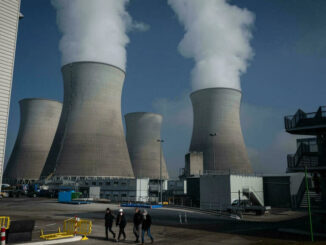
In a highly anticipated address set for July 23, 2025, President Donald Trump will deliver a speech titled “Winning the AI Race,” hosted by White House AI and crypto czar David Sacks alongside cohosts from the All-In podcast. The event aims to assert America’s edge in artificial intelligence (AI) amid intensifying rivalry with China, outlining a vision for U.S. dominance in this transformative technology.
As the energy sector braces for the ripple effects, this speech comes at a critical juncture where AI’s voracious energy demands are colliding with ongoing efforts to bolster the U.S. power grid.
Trump’s Track Record on AI: From Revocation to Deregulation
President Trump’s approach to AI has been marked by a swift pivot away from the previous administration’s regulatory framework. On his first day in office, January 20, 2025, Trump revoked Executive Order 14110, issued by President Biden in 2023, which focused on the safe, secure, and trustworthy development of AI.
🚨Big news for America’s future: @POTUS announced $90B in AI and energy investments for new data centers, power expansion, grid upgrades, and AI workforce training. We’re prioritizing innovation over regulation and boosting US leadership in tech & energy. https://t.co/vwHTejS3pc
— Secretary Doug Burgum (@SecretaryBurgum) July 15, 2025
This move was part of a broader rescission of what the administration deemed “harmful” policies, clearing the way for innovation without what Trump officials described as burdensome oversight.
Just days later, on January 23, 2025, Trump issued his own Executive Order titled “Removing Barriers to American Leadership in Artificial Intelligence.” This directive aimed to dismantle perceived obstacles to U.S. AI advancement, emphasizing deregulation to foster rapid growth and maintain global competitiveness.
Additionally, in the waning days of the Biden administration, an Executive Order on Advancing U.S. Leadership in AI Infrastructure was signed on January 14, 2025, focusing on building domestic capabilities for frontier AI models.
This rhetoric ties directly into the energy sector, where AI’s expansion is projected to strain resources significantly.
Department of Energy’s Push to Safeguard the Grid
The DOE has been at the forefront of initiatives to protect and modernize the U.S. power grid, recognizing its vulnerability amid rising demands from AI data centers and other high-energy industries. On April 8, 2025, President Trump signed Executive Order 14262, “Strengthening the Reliability and Security of the United States Electric Grid,” which prioritizes resilience against threats and ensures a reliable power supply.
This followed an earlier declaration of a National Energy Emergency on January 20, 2025, highlighting insufficient energy production as a threat to national security.
Key DOE actions include:
- Intervening in Plant Retirements: The agency has ordered coal- and gas-fired generators to delay planned closures, invoking nearly century-old provisions to maintain baseload capacity.
- Cybersecurity Enhancements: DOE has implemented strategies for grid cybersecurity, including mandatory standards approved by the Federal Energy Regulatory Commission (FERC), to counter digital threats.
- Funding for Protection Projects: In October 2024, DOE allocated approximately $2 billion to 46 projects aimed at fortifying the grid against physical and cyber risks.
These measures are crucial as AI-driven data centers emerge as a major consumer of electricity, potentially exacerbating grid vulnerabilities if not addressed.
The Grid Reliability Report: Sounding the Alarm on AI’s Impact
A recent DOE report on grid reliability, released in July 2025, paints a stark picture of the challenges ahead.
It warns that blackouts could surge 100-fold by 2030, jumping from single-digit annual outage hours to over 800, if the U.S. continues retiring reliable power sources without adequate replacements. The primary culprits? A 16% rise in electricity demand over the next five years, fueled by AI data centers (adding 35–108 GW of load) and advanced manufacturing.Key findings include:
- Capacity Shortfalls: Planned retirements of 104 GW—mostly coal—far outpace additions of reliable baseload capacity (only 22 GW from natural gas and nuclear out of 209 GW total planned).
- Regional Hotspots: High risks in PJM and ERCOT regions, each requiring 10.5 GW of new “perfect capacity” by 2030, while areas like ISO-New England and NYISO fare better.
- Planning Deficiencies: Current models overlook outage frequency, duration, and interregional ties, necessitating advanced analytics and a shift toward firm baseload sources like coal, natural gas, and nuclear over variable renewables.
The report critiques over-reliance on solar and wind, advocating for DOE interventions to preserve critical plants. It also highlights ties to AI, noting data centers’ role in demand spikes and calling for modernized grid technologies to handle them.
Opportunities for Investors in a Strained Energy LandscapeAmid these alarms, the report identifies silver linings for investors in the energy sector.
Companies focused on dispatchable power and grid innovation stand to gain, particularly those aligned with AI’s energy needs:
|
Company
|
Focus Area
|
Key Opportunities
|
|---|---|---|
|
Peabody Energy (BTU)
|
Coal production
|
Benefits from delayed retirements and baseload demand.
|
|
Constellation Energy (CEG)
|
Nuclear and clean energy
|
Recent deals with Microsoft and Meta for AI data center power via 20-year agreements.
|
|
NextEra Energy (NEE)
|
Renewables and storage
|
Grid modernization and balanced energy mix.
|
|
Vistra Corp (VST)
|
Diverse generation (gas, nuclear)
|
Exposure to high-demand regions like ERCOT.
|
|
GE Vernova (GEV)
|
Grid solutions and AI tech
|
Advanced technologies for data center support.
|
|
Fluence Energy (FLNC)
|
Energy storage
|
DOE’s Long Duration Storage initiatives.
|
These firms could see growth as policies prioritize reliability to support AI expansion, potentially lowering costs and enhancing security.
Looking Ahead: What the Speech Might Mean for Energy
With the U.S.-China AI race heating up, expect a call to “unleash” domestic energy resources, echoing recent executive actions and DOE reports.







